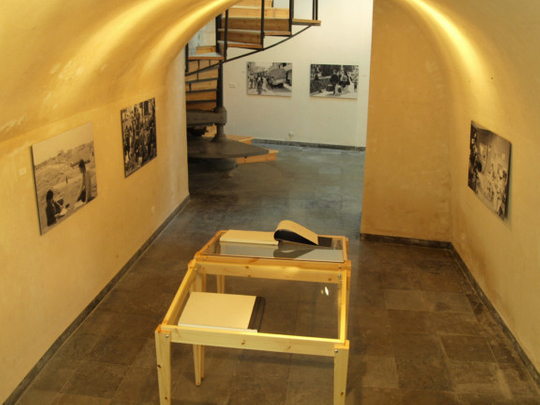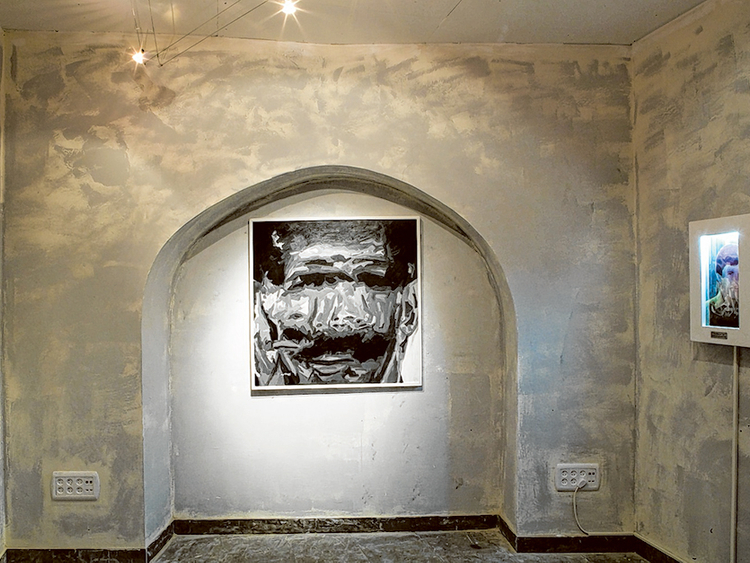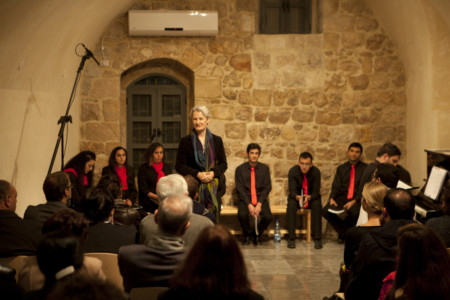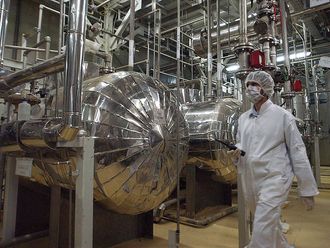
The struggle in east Jerusalem, especially in the Old City, has been ongoing since it was occupied in 1967 but the steely resolve of Palestinians in resisting with whatever means available to them and never yielding against immeasurable odds, is most admirable.
Al Ma’mal (The Factory) was originally a tile factory tucked within the walls of the Old City. After 1967, the Israeli Municipality issued regulations barring all factories from operating in the precincts of the walled city. Consequently the unused premises deteriorated but the municipality continued to levy taxes, with the owners — the Kassisieh family — compelled to engage in a lengthy and costly legal battle.
Eventually, art came to the rescue, with the family leasing the property to a group of Palestinians committed to preserving the cultural life of Occupied Jerusalem. In essence, the deal was — the group pays the taxes owed to the Israeli Municipality, renovate and use the property for the next 20 years. And thanks to a Unesco grant, it all came to fruition.
Jack Persekian, the director of Al Ma’mal, is enthusiastic about this new cultural landmark in Occupied Jerusalem, located in the converted tile factory. “Before this, Anadiel Gallery opened in 1992 at Salahuddin Street and moved to New Gate in the Old City in 1996, and began doing what we are doing here now, albeit on a smaller scale,” Persekian said.
“A group of friends then sought to create an NGO that would allow access to funds to sustain the growth, and this idea serendipitously coincided with the fate of the tile factory and its legal issue with the Israeli Municipality. The present chairman of Al Ma’mal is from the family that owns it. The idea was born to not let the property be lost on the pretext of taxes, to save the place, and most importantly, for the community to benefit from its use,” Persekian said.
“It all began in 1998, when it was announced in the papers that an organisation had obtained money from the Gulf, which it did not receive. Nevertheless, we began with the renovations but the Israeli Antiquities Authority stepped in, issuing fines and taking us to court for not possessing the necessary construction permit, which is almost impossible for Palestinians to obtain. This resulted in more money being spent on fines and legal issues.”
However, the group’s determination to pursue its dream did not falter. They rented a space across the property and started to work on their vision while monitoring and warding off any Israeli attempts to confiscate the unused factory.
Another challenge they faced was a double-edged sword — it was the time when the Palestinian National Authority (PNA) was being established in Ramallah and many arts and cultural institutions based in Occupied Jerusalem were moving there at the behest of the international donors who were unable to promote the arts because the PNA had no authority in the city unilaterally “annexed” by Israel.
Persekian recalls, “We decided it had to be [Occupied] Jerusalem, our vision was indeed a beacon in dark times. We were determined to be here in spite of all the difficulties, which resulted in a 15-year uphill struggle against all odds.”
After all these years, Al Ma’mal has been transformed into quite an impressive structure. Besides its lit-up and airy exhibition spaces, it boasts of some sensitive architectural touches: a spiral staircase takes you to the basement, with the occasional exposed glass flooring revealing the archaeological remains below, a constant reminder of the city’s heaving layers. A residential space offers a place for visiting international artists to stay and the rooftop, with its view of the Old City, plays host to regular events and concerts.
“Over the years, Anadiel Gallery and Al Ma’mal have produced and safeguarded a small yet important collection of artworks created by local and visiting artists invited by both entities.
They produced these pieces in the context of an engagement with the country, the people, the history and the ongoing conflict. This collection is being prepared for the launch of a project, Contemporary Art Museum Palestine (CAMP), an innovative nomadic museum. CAMP will move from place to place, with temporary homes under the auspices of host museums. The host museums across the globe will be invited to interact with CAMP and initiate projects and exhibitions,” Persekian says.
The Artist-in-Residency programme provides local and international artists accommodation and studio facilities for the creation, presentation, development and exchange of projects. This programme serves as a meeting place for artists, facilitating creative encounters and discussion forums open to the public, initiating communication between Palestine and the world. The artworks produced become part of Al Ma’mal’s collection and the nucleus of CAMP.
Persekian says: “We can’t get artists from West Bank or Gaza for this programme — that’s an impossible dream. The studio ends up accommodating mainly international artists who, on their return, cite their personal experiences and in a sense become ambassadors for Palestinian artists.
“The workshops — which are conducted by local and visiting artists — introduce visual art to youth, allowing art’s positive energy to touch their lives, creating an environment conducive for group interaction, cooperation, mutual understanding and tolerance. To date, we have conducted 20 workshops with over 800 youth participants,” he says.
The Public Outreach Programme features artists, writers, historians, musicians and performers who are invited for exhibitions, talks, readings, discussion circles, performances and film screenings. The exhibitions are organised every other month for visiting as well as resident artists focusing on themes dealing with Occupied Jerusalem’s and Palestine’s history and cultural heritage.
The Education Programme, organised in partnership with community centres, youth clubs and educational institutions, offers workshops led by both local and international artists for the youth from Occupied Jerusalem to engage in creative activity, with the intent to unearth hidden talent.
Persekian says, “The Jerusalem Show is a major cultural event organised and hosted primarily in and around the Old City, with art exhibitions, performances, workshops, talks, film screenings and guided tours. It takes the Old City both as a contextual starting point and as a venue, producing works and events that reflect on the importance of Occupied Jerusalem as an artistic, cultural, political and social urban space. In all, about 30 local and international artists are invited to present their projects each year and then every two years, the show becomes part of ‘Qalandiya International’, a biennial celebration of Palestinian art and culture organised in partnership with other Palestinian institutions.”
“We can’t allow Occupied Jerusalem to be taken out of the Palestinian context. We work outwards as the position from here is different. We are cut off by walls and checkpoints, and Palestinians from the West Bank and Gaza Strip can’t come to us. Therefore, we engage internationally in partnerships that help bring back context and relevance, as in the final analysis, it’s the people that matter,” Persekian says.
The tile factory, now Al Ma’mal, has assumed a unique identity as a cultural space in the heart of the Old City of Occupied Jerusalem, keeping the flame of creativity alive for the determined people here.
Rafique Gangat, author of “Ye Shall Bowl on Grass”, is based in Occupied Jerusalem.














